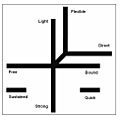Laban movement analysis facts for kids
Laban movement analysis (LMA) is a special way to describe and understand how people move. It was created by a person named Rudolf Laban and many others helped him.
Laban movement analysis was first made to write down dance moves. Before we had film and video, there was no easy way to record a dance. Dancers had to learn moves from older, experienced dancers. This made it hard to keep dances exactly the same over time.
This problem was especially big in modern dance. Modern dance uses many different kinds of moves, not just the usual ones. Later in his life, Laban also used his ideas to study how workers moved when they did physical jobs.
Contents
What is Laban Movement Analysis?
LMA uses ideas from different areas of study. These include how our bodies work (like anatomy and kinesiology) and how our minds work (psychology). It helps us understand the why and how of movement.
Who uses LMA?
Today, many people use LMA. These include actors, gymnasts, and especially dancers. It helps them understand and improve their movements.
How is LMA used today?
While LMA is still useful, video recordings are now very common. Video makes it much easier to record dance and other movements. LMA is not the only way to write down movement. Other systems exist too.
For example, long ago in the 1680s, Pierre Beauchamp had a system to write down baroque dance. Later, in 1887, Eadweard Muybridge started using early film to record how humans and animals moved. Film and video have really changed how we understand movement. But Laban's system was very important in its time.
Protecting Dance Moves
Dance moves that are written down using LMA, sometimes with video, can be protected. This means the person who created the dance can copyright their choreography. It helps make sure their original work is recognized.
Images for kids
See also
 In Spanish: Laban movement analysis para niños
In Spanish: Laban movement analysis para niños


